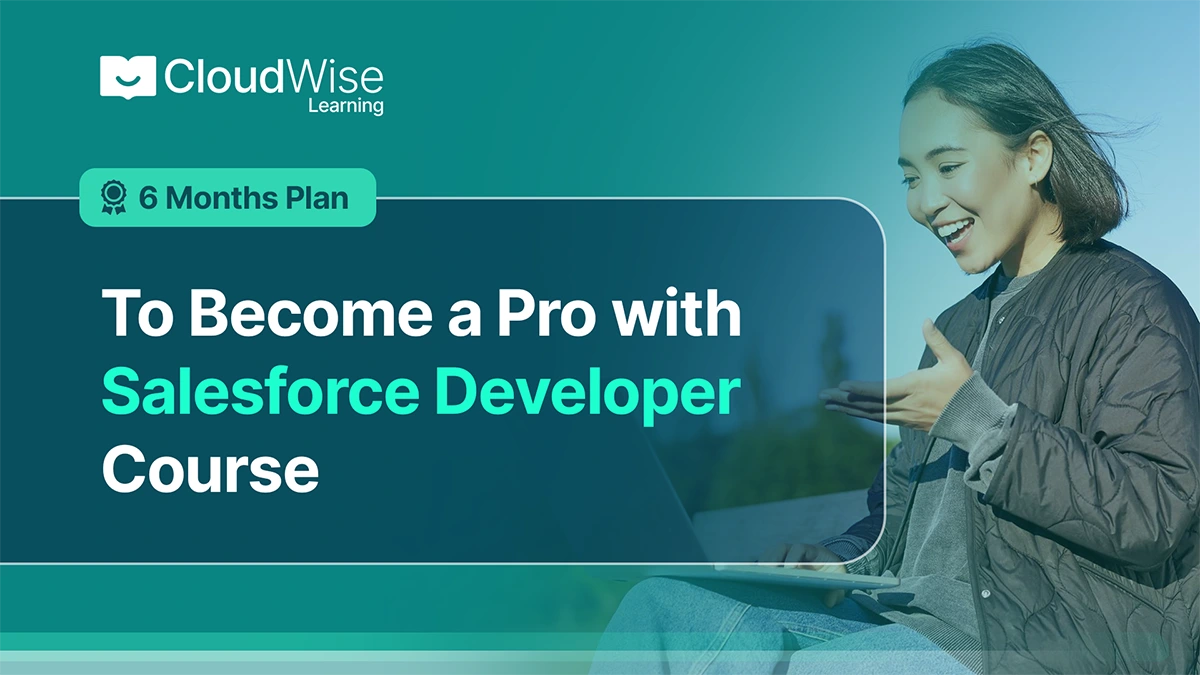No products in the cart.
6 Months Plan to Become a Pro with Salesforce Developer Course

A well-structured Salesforce Developer Course can be your gateway to one of the most in-demand tech roles today. As demand continues to grow, so does the earning potential of a Salesforce Developer, reaching up to a median base salary of $120,000. But those rewards don’t come without the effort to learn. The path to becoming a skilled developer can be overwhelming, especially without a clear roadmap to follow.
In this blog, we’ll walk you through a step-by-step 6-month plan designed to help you become a pro Salesforce developer using the right training resources. You’ll gain a clearer perspective of which skills you need to learn and have a smart way of building them.
Why 6 Months?
Learning a new skill requires time, focus, and consistency. However, many working professionals see time as a luxury. At first glance, six months might sound too long, but in reality, it’s the perfect balance between structure and flexibility.
In a six-month timeline, you can create a realistic and achievable learning path. It gives you enough time to build the right skills, develop muscle memory with hands-on practice, and grow comfortable with core concepts like Apex, SOQL, and Lightning Web Components. Instead of rushing through tutorials and modules, you have the time to learn, apply, and reinforce each step with intention.
If you go too fast, you risk burnout or knowledge gaps. On the other hand, if you go too fast, you might lose momentum or motivation. Six months offers the ideal pace: consistent progress without the pressure of cramming. It keeps you accountable while still allowing room to adjust around your schedule.

Month 1: Understand the Salesforce Platform & Ecosystem
Before touching any code, you need to understand Salesforce as a platform first. You need to know that it’s more than just a CRM. It is a powerful cloud platform used across sales, service, marketing, and more.
During your first month of learning, focus on fully grasping how the platform works. It’s also ideal that you get to know its architecture as well as the Sales Cloud and Service Cloud. After that, you need to get familiar with the Lightning Experience UI, how to navigate apps, records, and the Object Manager.
At the end of the first month, you should feel more comfortable navigating Salesforce and setting up to start building in your Developer Org.
Month 2: Master the Admin Foundations
During the second month, you need to dive into the core blocks of Salesforce, including objects, fields, and relationships. It’s essential to learn these elements because they form the data model that powers every Salesforce app. By this time, you need to get familiar with customizing objects, creating fields, and defining relationships that structure how data connects across Salesforce.
Since you’ve already explored the basics, it’s time to start exploring automation tools. Focus on learning about validation rules, workflows, and Flow Builder. By the end of the month, you should be able to build a fully functional app using point-and-click tools, laying the groundwork for more advanced development later on.
Month 3: Dive Into Apex
After you’ve gained an understanding of Salesforce on the surface, it’s time to get into coding slowly. Salesforce’s proprietary programming language is Apex, and it is strongly typed and object-oriented. You can think of it as Java for Salesforce that allows you to add and interact with data in the Lightning Platform persistence layer. Apex is essential for building custom backend logic.
During the 3rd month, you can start by learning Apex syntax, data types, loops, and control structures. Once you’re comfortable with the basics, slowly move on to writing Apex classes and triggers. This will allow you to automate actions every time a record is created, updated, or deleted. You also need to get acquainted with SOQL (Salesforce Object Query Language) and DML (Data Manipulation Language), which are used to retrieve and modify data within the platform.
If you think this is too complex for self-paced learning, you can consider enrolling in Salesforce Developer courses such as the DEX450. With the right training and expert guidance, you can be assured that you’ll learn how to write and test simple Apex triggers and batch jobs by the end of the 3rd month.

Month 4: Explore Visualforce and Lightning Web Components
Your 4th month should be focused on learning how to build user interfaces in Salesforce. Take note that before jumping into learning skills, you need to understand the evolution from Visualforce to Aura, then to Lightning Web Components (LWC). Although Salesforce now recommends LWC, it’s still important to know when and why to use the other two.
After the theory comes your practice. If you already have a background in basic JavaScript, start by building your own Lightning Web Component (LWC). It’s also ideal to start using tools like the Developer Console and Visual Studio Code with Salesforce Extensions to write and deploy your code more efficiently.
By the end of the month, you should be able to deploy your first Lightning Web Component into a custom app page. This is a big step in making your apps both functional and user-friendly.
Month 5: Work with Real Projects
A learning journey isn’t complete without putting your skills to the test. By this month, you should be prepared to build a real-world app from scratch. You can start with a custom helpdesk system or a lead tracking tool, just to test everything you’ve learned.
Along the way, you’ll also learn Salesforce integrations, starting with REST API basics. Do not skip this part because knowing how to connect Salesforce to external systems is a valuable skill, especially if you work for an organization with multiple platforms.
For the 5th month, your goal is to launch a full-featured app and publish it as part of your developer portfolio. This not only builds confidence but also gives you a real project to showcase to employers.
Month 6: Get Certified
In the final month, start focusing on getting Salesforce certified. This period should be used to study for the Salesforce Platform Developer I exam. You can take practice tests and review missed concepts to prepare, or you can also join communities for accountability and support.
By the end of Month 6, your goal is to schedule and pass the Platform Developer I exam and start applying for roles. After completing 6 months of focused training, you now have the skills and confidence to work your way as a Salesforce developer.
Start Your Salesforce Developer Journey with CloudWise Learning
It’s possible to become a Salesforce Developer in just six months if you have the right roadmap, resources, and training. This period is enough not only to master theories and concepts but also to apply them by building real-world applications. However, complex roles sometimes need expert guidance.
At CloudWise Learning, we make sure you get the most out of those six months with our instructor-led classes. We offer focused Salesforce developer courses for learners who want to move with purpose. No matter where you are in your learning journey, we have courses that can be your excellent companions in this 6-month plan. These expert-led programs provide the technical depth, hands-on projects, and exam-focused preparation needed to earn your Platform Developer I certification with confidence.
We have the right tools, trainers, and track record to help you succeed.
Ready to take the next step? You can talk to us to get started or explore more Salesforce Developer courses on our website to find the right fit for your goals.
Explore Our Other
Resources
Dive into our Resource Center, where you can explore a wealth of expert blogs. Discover detailed industry insights and stay informed on the latest trends. Enrich your knowledge with our comprehensive resources.
FAQ
Do you offer custom training?
Yes, we can run classes for your company and tailor the content in most instances. Please get in touch with us at info@layer8training.com, and we can discuss options.
How do I enroll in a class?
To enroll in a class, check out online or call us at 888-504-8872. You can also contact us through email at info@layer8training.com
